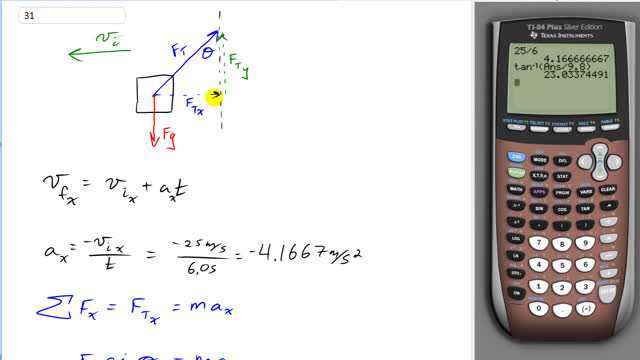
An object is hanging by a string from your rearview mirror. While you are decelerating at a constant rate from 25 m/s to rest in 6.0 s,
- what angle does the string make with the vertical, and
- is it toward the windshield or away from it? [Hint: See Example 4–15.]

In order to watch this solution you need to have a subscription.
This is Giancoli Answers with Mr. Dychko. The car is initially going to the left say. And then it decelerates and this object hanging by a mirror is going to swing towards the windshield a bit so that the tension force has some component that will make this object decelerate as well. So, need some horizontal component to the right. Now, we can calculate what the acceleration of the object will be in the x direction. It'll have no acceleration vertically. And from that we can figure out the x component of the tension force or at least create an expression for that x component. We won't know all the values to plug in to find it as a number but then we can say that the vertical component of the tension force equals gravity, and then combine those two expressions to get our answer. So, let's start by finding the acceleration. So, we have the final velocity in the x direction is zero. So, we subtract Vix from both sides and then also divide by t. And we get acceleration is the opposite of the initial velocity in the x direction divided by t. So, that's negative of 25 meters per second that it started with divided by 6.0 seconds which is negative 4.1667 meters per second squared. So, I have, maybe that's a bit confusing, I have positive to the left. I have forgot the initial velocity being positive and have written it to the left, so, that means positive is to the left here, and so, a negative acceleration is to the right. So, the sum of all the forces in the x direction consists of just one force, this X component of the tension, and that equals mass times acceleration in the x direction because that's what the net force is according to Newton's second law. And then the X component of this tension will be the tension force multiplied by sine theta because this x component is opposite to the angle theta. And we've put theta up here with respect to the vertical because that's what the question asks us for, tell us the angle with respect to vertical. And so, it's a bit unusual to have x components being found using sine, we're often using cosine to find x components. But, you know, don't rely on that rule. We always have to look at your picture to figure out which trig function to use. And that's as far as we can go with this line of thinking with the x direction because we don't know the tension force nor do we know the angle. So, with two unknowns in this equation there's nothing more we can do with it. So, we need to find a second equation to work with. And so, we'll consider the y direction. And the forces in the y direction add up to zero and there's one going up, the y component of tension. And then that has to equal the force going down, gravity, which is mg. So, we have the tension force times cos theta because that gives you the adjacent leg, equals mg. And we can solve for the tension force by dividing both sides by cos theta to get this next line here. And that's as far as we can go with that but here's where we combine the two formulas now. So, I'm gonna take this expression for the tension force and plug it into this equation up here and replace FT with mg over cos theta to get this and then, you know, rewrite the sine theta equals max. So, that is copied here. And we've substituted for FT using the stuff we learned from considering the vertical direction. And sine theta over cos theta can be written as tan theta, you just have to know that, sine theta over cos theta is always tan theta. And we can do a bit more algebra and divide both sides by mg. And the m's will cancel everywhere. Sine theta over cosine became tan theta and the g disappears in the left and ends up in the denominator on the right. And we have this expression then. So, take the inverse tangent of both sides and you get theta is inverse tangent of the acceleration in the x direction divided by acceleration due to gravity, so, that's inverse tangent of 4.1667 divided by 9.8 which is 23 degrees, and that's towards the windshield.
why is it towards the windshield
Hi k_deepa25, thanks for the question. The object is moving forwards, but it's decelerating so it needs a force pulling back. The only way for a string to have a horizontal component of force backwards is if the object swings toward the windshield.
Best wishes with your studies,
Mr. Dychko